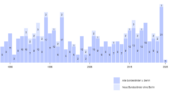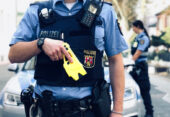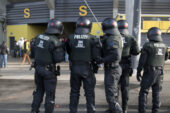In Frankfurt, two full-time officers are now working for the humanoid facial recognition. Every day, they compare current wanted persons with existing pictures in police databases. The procedure is also supposed to work with concealed faces.
Since November 2020, the Hessian police have been testing the use of so-called “Super Recognisers” for everyday investigations, manhunts, at events and political assemblies. These are people with the talent to memorise faces and recognise them in pictures or even in a crowd.
An estimated one to two percent of all people are said to have this ability, British scientist Josh Davis found out within the Metropolitan Police. In the course of his study for the University of Greenwich, he noticed that the same officers were always able to identify a particularly large number of suspects on video footage. Recognition is said to be possible even if the image of the person being searched is a photo that is several years old.
Deployed at protests, Christmas markets and football stadiums
Davis subsequently supported the police in Munich in setting up such a unit, and deployments have since taken place at admission control and at the “video workstation” of the Oktoberfest, among other things. In 2017, even before the official start of the unit, six Bavarian officers supported the “Black Block” special commission in Hamburg, which was set up after the G20 summit, in viewing video footage.
Since 2018, Baden-Wuerttemberg has identified several “Super Recognisers” in its own ranks; in June 2020, they are said to have played a significant role in the investigation of the “Stuttgart riot night”. In the meantime, all police trainees at the state Police College undergo a corresponding identification procedure, and assignments are also carried out at Christmas markets or football stadiums. In addition to Berlin, Saxony is now also planning a similar pilot project.
Scanning images from camera surveillance
So far, 1,000 participants of the Frankfurt police have passed the test for “Super Recognisers”, and 45 of them were found to have special memory skills. Two officers are now working full-time for this purpose. Every day, they compare current wanted persons with picture data of known perpetrators or suspects. In their investigations, the officers also search through still images from video cameras in public spaces. If necessary, the full-time officers are assisted by the other colleagues who have been found to have the ability.
According to the Hessian Ministry of the Interior, the Super Recognisers” also made possible the arrest of a suspect at Frankfurt Central Station. The suspect had tried to kill a person with a knife. Based on images from a video camera, he was found in the police’s image database.
Fragments of the face should be sufficient for recognition
Since May 2021, the Hessian police claim to have recognised persons in more than 400 cases. Experience has shown that officers can identify faces or persons even if only fragments of the face are available as image material or if the persons have changed their appearance. This had already been reported by the police chief Gerhard Bereswill on the occasion of the protests against the further construction of the A49 in Dannenröder Forst. There, activists had covered themselves with scarves or painted their faces. With the use of “Super Recognisers”, it was finally possible to identify people who had destroyed their papillary lines on their fingertips, Bereswill stressed.
The “Super Recognisers” will now become a permanent feature at all seven Hessian police headquarters. This was announced by the Minister of the Interior, Peter Beuth (CDU), after a visit to the police in Frankfurt on Thursday. A fortnight ago, the Ministry of the Interior had organised a kick-off event for this purpose. In autumn, state-wide tests are to begin to find out which officers have the skills. The police use the test procedure of the University of Greenwich, which is available on the internet.
Image: Merianplatz Frankfurt, universaldilletant, CC BY-NC-SA 2.0.





Leave a Reply